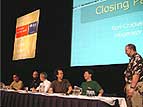| |
|
|
CONTACT JAOO
JAOO Conference
Scandinavian Center
Margrethepladsen 3
DK-8000 Aarhus C
Tel.:+45 87 32 87 87
Fax: +45 87 32 87 88
VAT: 25809149
jaoo@jaoo.dk
|

|
|
|
 |
|
Speaker
|
Gregor
Hohpe
ThoughtWorks
Gregor Hohpe leads the Enterprise Integration Services practice at
ThoughtWorks, Inc., a provider of application development and
integration services to the Global 1000. Gregor has over 10 years
experience designing and implementing large-scale business solutions,
having witnessed the evolution from client-server architectures to
multi-tiered applications, Web-enabled applications, enterprise
integration and service-oriented architectures.
For the past years, he has helped clients around the globe with the design and implementation of enterprise integration and service-oriented solutions.
His current work focuses on the application of agile methods and design patterns to
the development of integration solutions. Gregor has published a number
of articles presenting a no-hype, down-to-earth view on enterprise
integration, Web Services and Service-Oriented Architectures and is a
frequent speaker at technical conferences. His book titled Patterns of
Enterprise Integration, co-authored with Bobby Woolf, is due to be
published later this year.
|

|
Presentation: "Enterprise Integration Patterns"
Monday 15:15 - 16:00, Conference Hall
In today's business environments, users and customers expect instant access to all business functions and "straight-through" processing of incoming customer requests. However, in most enterprises a single business function can span across many systems such as customer-facing systems, accounting systems, inventory systems etc. As a result, these disparate systems have to be integrated to allow a coordinated flow of data and functionality across the enterprise.
EAI (Enterprise Application Integration) suites and, more recently, Web Services standards provide tools for integration, but also introduce new challenges. Creating a robust integration solution remains a complex and difficult task. The asynchronous nature of most message-based integration solutions is different from the (synchronous) world of application development and requires architects and developers to adopt new design, development and testing strategies.
This session uses patterns to convey critical aspects of integration design. Using these patterns, integration solutions can be composed of well-defined, reusable building blocks. The patterns have been harvested from years of actual integration projects using messaging, Web Services and EAI tools.
This talk is not an introduction into specific technologies such as SOAP or JMS, but instead deals with the challenges of designing complete integration scenarios using messaging. The proposed solutions can be applied to a variety of tools.
Enterprise Integration Patterns - (slides)
Please notice that the slides are password protected. You should have received an e-mail containing the required username and password.
|
Presentation: "Test-Driven Enterprise Integration"
Tuesday 15:15 - 16:00, Private Room
If testing software applications is a good idea, testing enterprise integration solutions must be an excellent idea. After all, integration solutions form the backbone of many modern enterprises, linking vital systems and business processes with real-time data interchange. Any defect or outage in an integration solution is likely to affect large portions of the enterprise, potentially causing loss of revenue and data.
Besides the obvious damage done to the business by defective software, the lack of a structured testing approach also causes delays and unnecessary work during the software development cycle. A test-driven approach integrates automated tests into the requirements and analysis phases of a project, resulting in higher-quality applications and more expeditious integration and deployment cycles.
It is surprising then that so many integration solutions are deployed with little or no testing. Testing, if any, is usually done manually and sporadically. One of the reasons integration solutions are not tested thoroughly is the fact that testing asynchronous, message-based middleware solutions is challenging. These solutions are complex, distributed, heterogeneous and asynchronous in nature. To make things worse, there are very few tools available to aid in these testing efforts.
This talk examines the challenges of testing enterprise integration solutions and proposed a testing approach to tackle the inherent complexities. The proposed best practices apply to traditional EAI solutions as well as Web services.
Test-Driven Enterprise Integration - (slides)
Please notice that the slides are password protected. You should have received an e-mail containing the required username and password.
|
|
|
|
|

